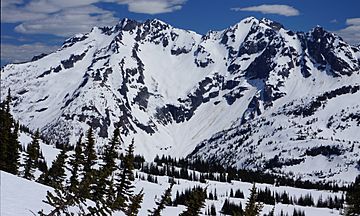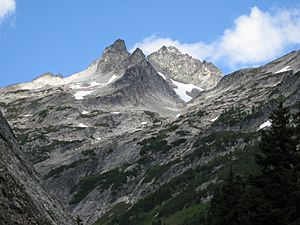Dumbell Mountain facts for kids
Quick facts for kids Dumbell Mountain |
|
|---|---|

Greenwood and Dumbell seen from Cloudy Pass
|
|
| Highest point | |
| Elevation | 8,421 ft (2,567 m) |
| Prominence | 1,261 ft (384 m) |
| Parent peak | Seven Fingered Jack (9,100 ft) |
| Geography | |
| Parent range | Entiat Mountains North Cascades Cascade Range |
| Topo map | USGS Holden |
| Geology | |
| Age of rock | Cretaceous |
| Type of rock | Dumbell Mountain plutons gneissic hornblende quartz diorite |
| Climbing | |
| First ascent | 1932 Richard Alt, George Fahey |
| Easiest route | Scrambling |
Dumbell Mountain is a tall mountain in Washington state. It stands 8,421-foot (2,567-metre) high. This mountain has two main peaks, which is why it's called a "double summit." It is located in the Glacier Peak Wilderness area. This wilderness is part of the North Cascades mountain range.
The main peak of Dumbell Mountain is a little taller than its neighbor. That neighbor is a peak called Greenwood Mountain. The closest higher mountain is Chiwawa Mountain. It is about 2.4 mi (3.9 km) to the east-southeast. Rain and melting snow from Dumbell Mountain flow into the Chelan River and the Wenatchee River. A person named Albert Hale Sylvester gave the mountain its descriptive name. He was an early surveyor and explorer in the Cascades.
How Dumbell Mountain Was Formed
Dumbell Mountain is part of a large rock formation. This formation is called the Cloudy Pass batholith. It was formed about 20 million years ago. This happened during a time called the early Miocene period.
The Cascade Mountains began forming millions of years ago. This was during the late Eocene Epoch. The North American Plate is a huge section of the Earth's crust. It moved over the Pacific Plate. This movement caused many volcanoes to erupt.
Small pieces of the Earth's crust also joined together. These pieces are called terranes. They helped create the North Cascades about 50 million years ago.
During the Pleistocene period, glaciers covered the land. This was over two million years ago. These huge ice sheets moved forward and then melted back many times. This process carved out the landscape. Most valleys were free of ice about 12,000 years ago.
The land was also pushed up and broken by faults. This, along with the glaciers, created the tall peaks. It also formed the deep valleys you see in the North Cascades today.
Volcanic activity started to increase about 35 million years ago. This was during the oligocene period. Glacier Peak is a large volcano southwest of Dumbell Mountain. It began to form in the middle of the Pleistocene period.
Weather Around Dumbell Mountain
Dumbell Mountain is in a marine west coast climate zone. This means it gets a lot of moisture from the Pacific Ocean. Most weather systems come from the Pacific Ocean. They travel northeast towards the Cascade Mountains.
When these weather systems reach the North Cascades, the mountains force them upward. This causes the air to cool. The moisture in the air then falls as rain or snow. This is called Orographic lift. Because of this, the western side of the North Cascades gets a lot of rain and snow. This is especially true in winter.
The climate here is mild because it's close to the Pacific Ocean. Temperatures rarely go below 0 °F (−18 °C) in winter. They also rarely go above 80 °F (27 °C) in summer. Winters are usually cloudy. However, high pressure systems over the Pacific Ocean bring clear skies in summer. The snow here tends to be wet and heavy. This can create a high risk of avalanches.
Images for kids





